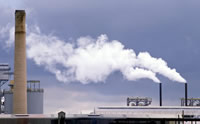
By Timothy P. Fagan, BLR Air Expert
tfagan@blr.com
After identifying the sources in your facility that have the potential to emit air pollutants into the atmosphere, determining the types and quantities of pollutants emitted, often referred to as preparing an emissions inventory, are essential tasks that can help answer some important questions:
- Does the facility need a permit?
- What kind of permit is needed?
- How do I demonstrate compliance with my existing permit conditions and regulatory requirements?
- Will adding or modifying a source trigger additional permitting and/or regulatory requirements?
Actual vs. Potential Emissions
Often when preparing an emissions inventory, and especially in support an air permit application, both actual and potential emissions are calculated. Actual emissions are based the actual operations of the facility, whereas potential to emit (PTE) is typically determined based on the facility operating at maximum capacity for 8,760 hours a year. EPA defines a facility’s PTE as the maximum capacity of a stationary source to emit any air pollutant under its physical and operational design. This may include air pollution control equipment and restrictions on hours of operation, or on the type or amount of material combusted, stored, or processed, if the limitation is federally enforceable.
The Pollutants
Typically, when preparing an emissions inventory the following regulated pollutants are quantified:
- Sulfur dioxide;
- PM-10;
- PM-2.5;
- Nitrogen oxides;
- Volatile organic compounds;
- Carbon monoxide;
- Individual and aggregate hazardous air pollutants;
- Greenhouse gases in the form of carbon dioxide equivalents (CO2e); and
- Other pollutants specified by state or local regulatory agencies.
Methods of Calculation
Some of the methods used to compile an emissions inventory include:
-
- Direct measurement. Direct measurement is the use of a continuous emissions monitoring system to monitor and record emissions of selected pollutants. Direct measurement is accurate but expensive and sometimes technically infeasible.
- Stack tests. Stack tests can be performed on specific sources or groups of sources to determine various emissions rates under a set or sets of specific operating parameters. The results can be utilized to predict emissions from the source as it operates at parameters similar to the test. In order for the stack test results to be useful, the parameters under which stack tests are performed must be carefully selected to provide an accurate representation of source operations. Stack tests are expensive and in some instances are required by regulations. See this guidance for assistance when conducting stack tests under the Clean Air Act.
- Emissions factors. Emissions factors are the most common and inexpensive method of calculating emissions and are derived from actual emissions measurements from various processes. Emissions factors are applied to processes similar to the one used to derive the factor in order to estimate emissions. Emissions factors are available from many sources such as EPA, professional societies, equipment manufacturers, etc. The most commonly referenced source of emissions factors is EPA‘s Compilation of Air Pollutant Emission Factors, Volume I: Stationary Point and Area Sources, otherwise known as AP-42. The reliability of emissions factors can be called into question if there are differences between your source and those used to determine the factor, or if the factor is based on a limited number of sources. So take care to evaluate the limitations associated with chosen emissions factors.
- Mass balance. In its most simplistic form, a mass balance is used to calculate emissions by equating the input to a process with the output of the process, with the difference assumed to be lost as air emissions. However, mass balances can become significantly more complicated when taking into account chemical reactions, accumulation, depletion, etc.
- Modeling. In some cases, computer models have been developed to calculate emissions based on specific input data.
- Engineering judgment. In the absence of any other acceptable methodology to calculate emissions, engineering judgment may sometimes be acceptable, provided enough supporting documentation is provided to allow the regulating agency to logically understand how the estimation was made.
Knowing what and how much your facility emits or could potentially emit is essential if you want to remain in compliance with applicable air regulations and permit conditions, so take the time to compile an accurate and economically feasible emissions inventory.
Additional Resources:
I’d like to do a series of posts on air permit training. Leave a comment or send me an e-mail and tell me what training topics are most important to you.
Timothy P. Fagan is a Legal Editor for BLR’s environmental publications, focusing primarily on air quality related topics. Mr. Fagan has covered environmental developments with BLR since 2000. Before joining BLR, he spent 5 years in environmental consulting and was responsible for air quality permitting and compliance for a broad range of industries in both the private and public sector. He received a Bachelor of Science degree in chemical engineering from Villanova University and a Master’s degree in environmental engineering from the Pennsylvania State University.

1 thought on “Air Permitting Training: The Emissions Inventory”